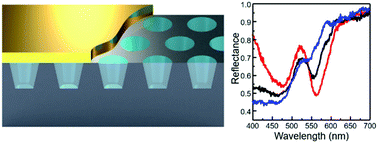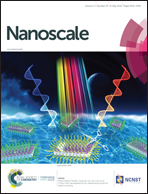Near-atomically flat, chemically homogeneous, electrically conductive optical metasurface†
Abstract
Metasurfaces, or two-dimensional arrays of subwavelength-scale structures, can exhibit extraordinary optical properties. However, typical metasurfaces have a bumpy surface morphology that may restrict their practical applications. Here, we propose and demonstrate an optical metasurface that is composed of a thin metallic film, with hidden dielectric structures underneath, and a metal back mirror layer. Exploiting the large difference between the Thomas–Fermi screening length for longitudinal electric fields and the skin depth for transverse electromagnetic fields, the near-atomically flat top surface of the proposed structure can appear homogeneous chemically and electrically but highly inhomogenous optically. The size and shape of the hidden dielectric structures as well as the thickness of the top metallic layer can be tailored to acquire desired optical properties. We performed both theoretical and experimental studies of the proposed metasurface, finding a good agreement between them. This work provides a new platform for ultra-flat optical devices, such as a wavelength selective electrode, diffusive back reflector, meta-lens, and plasmonically enhanced optical biosensors.



 Please wait while we load your content...
Please wait while we load your content...